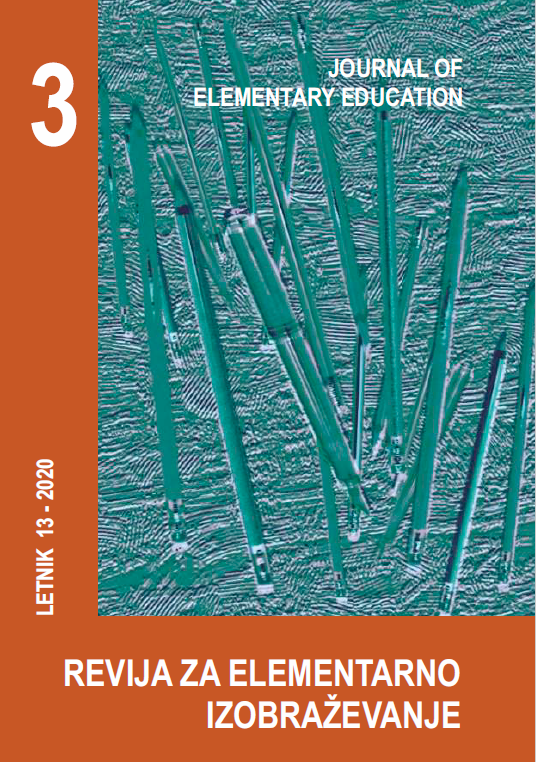Glasbene preference šolarjev glede otroških pesmi v duru in molu
Abstract
Students' musical preferences in childrens' major- and minor-key songs. This paper explores elementary school students’ music preferences in terms of songs authored for children and traditional major- and minor-key songs and the influence of familiarity of the music on their music preferences. The questionnaire and sound questionnaire were administered to 216 students attending the second, third, seventh and eighth grades of elementary school in Sinj, Croatia. The results confirm the influence of age and gender on students’ music preferences concerning songs authored for children and traditional songs in major and minor keys. Furthermore, all the participants prefer major-key songs to minor-key songs. Finally, it was established that familiarity with a piece of music is a significant factor affecting the music preferences of the participants.
Downloads
References
Adachi, M., & Trehub, S. E. (1998). Children’s Expression of Emotion in Song. Psychology of Music, 26 (2), 133-153. doi: .1177/0305735698262003
Bowling, D. L., Sundararajan, J., Han, S., & Purves, D. (2012). Expression of Emotion in Eastern and Western Music Mirrors Vocalization. PLoS ONE, 7(3), e31942. doi:10.1371/journal.pone.0031942
Carper, K. (2001). The effects of repeated exposure and instructional activities on the least preferred of four culturally diverse musical styles with kindergarten and pre-k children. Bulletin of the Council for Research in Music Education, 151, pp. 41–50.
Christenson, P. G., & Peterson, J. B. (1988). Genre and gender in the structure of music preferences. Communication Research, 15, pp. 282–301. doi: 10.1177/009365088015003004
Crowder, R. G. (1984). Perception of the major/minor distinction: I. Historical & theoretical foundations. Psychomusicology: A J ournal o f R esearch i n M usic C ognition, 4 (1–2), pp. 3–12. doi:10.1037/h0094207
Curtis, M. E., & Bharucha, J. J. (2010). The minor third communicates sadness in speech, mirroring its use in music. Emotion, 10(3), pp. 335–348. doi: 10.1037/a0017928
Dobrota, S., & Reić Ercegovac, I. (2014). Student’s musical preferences: the role of music education, characteristics of music and personality traits. Croatian Journal of Education, 16, pp. 363–384.
Dobrota, S., & Reić Ercegovac, I. (2016). Why we love what we listen to: music-pedagogical and psychological aspects of musical preferences. Split: Faculty of Humanities and Social Sciences University of Split.
Dobrota, S., & Reić Ercegovac, I. (2015). The relationship between music preferences of different mode and tempo and personality traits – implications for music pedagogy. Music Education Research, 17, pp. 234–247. doi: 10.1080/14613808.2014.933790
Finnäs, L. (1989). How can music preferences be modified? A research review. Bulletin of the Council for Research in Music Education, 102, pp. 1–58.
Gregory, A. H., Worrall, L., & Sarge, A. (1996). The development of emotional responses to music in young children (1996) Motivation and Emotion, 20(4), pp. 341–348, doi: 10.1007/BF02856522
Hargreaves, D. J. (1982). The development of aesthetic reactions to music. Psychology of Music. Special Issue, pp. 51–54.
Harrison, A. C., & O'Neill, S. A. (2003). Preferences and children’s use of gender-stereotyped knowledge about musical instruments: Making judgements about other children's preferences. Sex Roles, 49, pp. 389–400.
Hunter, P.G., Schellenberg, E.G., & Schimmack, U. (2010). Feelings and perceptions of happiness and sadness induced by music: Similarities, differences and mixed emotions. Psychology of Aesthetics, Creativity, and the Arts, 4(1). pp. 47–56. doi:10.1037/a0016873
Kastner, M. P., & Crowder, R. G. (1990). Perception of the Major/Minor Distinction: IV. Emotional Connotations in Young Children. Music Perception 8(2):189-201, doi: 10.2307/40285496
Kratus, J. (1993). Eminence in music education research as measured in the Handbook of Research on Music Teaching and Learning [Electronic version]. Bulletin of the Council for Research in Music Education, 118, pp. 21–32.
Ladinig, O. & Schellenberg, E.G. (2012). Liking unfamiliar music: Effects of felt emotion and individual differences. Psychology of Aesthetics, Creativity, and the Arts, 6(2), pp. 146–154. doi:10.1037/a0024671
LeBlanc, A. (1991). Effect of maturation/aging on music listening preference: a review of the literature. Paper presented at the Ninth National Symposium on Research in Music Behaviour, Canon Beach, Oregon, U. S. A.
Mirković-Radoš, K. (1996). Psihologija muzike. Beograd: Zavod za udžbenike i nastavna sredstva.
Nawrot, E. S. (2003). The Perception of Emotional Expression in Music: Evidence from Infants, Children and Adults. Psychology of Music, 31(1), pp. 75–92. doi:10.1177/0305735603031001325
North, A. C. & Hargreaves, D. J. (2008). The Social and Applied Psychology of Music. New York: Oxford University Press.
Schellenberg, E.G. & Von Scheve, C. (2012). Emotional cues in American popular music: Five decades of the Top 40. Psychology of Aesthetics, Creativity, and the Arts, 6(3), pp. 196–203. doi:10.1037/a0028024
Temperley, D., & Tan, D. (2013). Emotional Connotations of Diatonic Modes. Music Perception: An Interdisciplinary Journal, 30(3), pp. 237–257. doi:10.1525/mp.2012.30.3.237
Turner, B., & Huron, D. (2008). A comparison of dynamics in major- and minor-key works. Empirical Musicology Review, 3(2), pp. 64–68.
Copyright (c) 2020 Snježana Dobrota, Maja Gusić

This work is licensed under a Creative Commons Attribution 4.0 International License.
